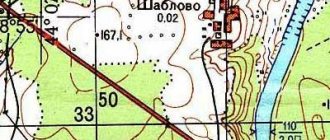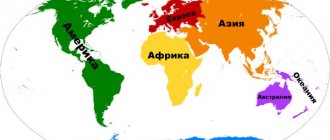Climate zones are continuous or discontinuous areas that are located parallel to the latitudes of the planet. They differ among themselves in the circulation of air flows and the amount of solar energy. Terrain and proximity to the sea or ocean are also important climate-forming factors.
According to the classification of the Soviet climatologist B.P. Alisov, there are seven main types of Earth's climate: equatorial, two tropical, two temperate and two polar (one each in the northern and southern hemispheres). In addition, Alisov identified six intermediate zones, three in each hemisphere: two subequatorial, two subtropical, as well as subarctic and subantarctic.
Arctic and Antarctic climate zone
Arctic and Antarctic climate zone on the world map
The polar region adjacent to the North Pole is called the Arctic. It includes the territory of the Arctic Ocean, the outskirts of North America and Eurasia. The belt is represented by icy and arctic deserts, which are characterized by long, harsh winters. The maximum summer temperature is +5°C. Arctic ice affects the Earth's climate as a whole, preventing it from overheating.
The Antarctic belt is located in the very south of the planet. Antarctica and nearby islands are under its influence. The pole of cold is located on the mainland, so winter temperatures average -60°C. Summer temperatures do not rise above -20°C. The territory is located in the arctic desert zone. The continent is almost completely covered with ice. Land areas are found only in the coastal zone.
What are the different climate zones?
Since these bands are very homogeneous in their climatic indicators, scientists clearly classify them into seven main and six transitional ones with clearly defined boundaries. They arise due to the constant circulation of water, solar heat and atmospheric fronts, which ultimately creates certain climatic conditions in different zones.
So, on the territory of the main zones - equatorial, tropical (two), temperate (two), polar (Arctic and Antarctic) - an air front of the same name is observed throughout the year.
Belts
Since there is no sharp change in climatic conditions in certain areas - the junctions of belts, it was decided to designate transition areas with the addition of “sub”:
- subequatorial (2)
- subtropical (2)
- subpolar (subarctic and subantarctic).
The air flows in them change seasonally: in the summer months they come from the belt located to the south, in the winter months - from the one to the north.
Subarctic and Subantarctic climate zone
Subarctic and Subantarctic climate zone on the world map
The subarctic zone includes Northern Canada, southern Greenland, Alaska, northern Scandinavia, northern regions of Siberia and the Far East. The average winter temperature is -30°C. With the arrival of short summer, the temperature rises to +20°C. In the north of this climate zone, tundra dominates, which is characterized by high air humidity, swampiness and frequent winds. The south is located in the forest-tundra zone. The soil has time to warm up during the summer, so shrubs and woodlands grow here.
Within the subantarctic belt are the islands of the Southern Ocean near Antarctica. The zone is subject to seasonal influence of air masses. In winter, arctic air dominates here, and in summer masses come from the temperate zone. The average winter temperature is -15°C. Storms, fog and snowfalls often occur on the islands. During the cold season, the entire water area is occupied by ice, but with the onset of summer they melt. Indicators for warm months average -2°C. The climate can hardly be called favorable. The flora is represented by algae, lichens, mosses and herbs.
Table of climate zones
The table shows the characteristics of the zones.
| Belt | Average temperature in January | Average temperature in July | Atmosphere |
| Equatorial | +25 | +25 | Moist warm air masses |
| Subequatorial | +20 | +31 | Monsoons prevail |
| Tropical | +10 | +37 | Trade winds |
| Subtropical | +8 | +40 | Cyclonicity, high atmospheric pressure |
| Moderate | +2…-20 | +19 | Western winds and monsoons |
| Subarctic | -25 | +8 | Cyclones |
| Arctic (Antarctic) | -40 | 0 | Anticyclones |
Temperate climate zone
Temperate climate zone on the world map
A quarter of the entire surface of the planet lies in the temperate zone: North America, Europe and Asia. Its main feature is the clear expression of the seasons of the year. The prevailing air masses produce high humidity and low pressure. The average winter temperature is 0°C. In summer the mark rises above fifteen degrees. The prevailing cyclones in the northern part of the zone provoke snow and rain. Most of the precipitation falls as summer rain.
Areas inland of continents are prone to drought. Natural zones are represented by alternating forests and arid regions. In the north, taiga grows, the flora of which is adapted to low temperatures and high humidity. It is gradually replaced by a zone of mixed broad-leaved forests. A strip of steppes in the south encircles all continents. The semi-desert and desert zone covers western North America and Asia.
Temperate climates are divided into the following subtypes:
- nautical;
- temperate continental;
- sharply continental;
- monsoon.
Road climatic zoning in Russia
The road-climatic zone is a part of the country's territory that is characterized by homogeneous features of the construction of highways, approximately the same climatic conditions, average uniformity of the water surface and approximately similar indicators of soil freezing and groundwater depth.
Best articles : Chinese Powder Crested Dog: Secrets of Grooming
Brief characteristics of road climate zones
| Road climate zones | Approximate boundaries and brief description of each of the road climatic zones |
| 1 | Cold tundra, covered with forest and permafrost are located north of the line of designated cities: De-Kastri - Birobidzhan - state border - Kansk - Tunguska - Sukhaya - Oshkurya - Nes - Ponoy - Monchegorsk. |
| 2 | Forests with constantly abundantly moistened soils are located from line 1 to the border of line 2: state border - Kansk - Tomsk - Kyshtym - Ustinov - Gorky - Tula. |
| 3 | Next lies the forest-steppe with periodically abundantly moistened soils: Turan - Biysk - Omsk - Magnitogorsk - Kuibyshev - Belgorod - Kirovograd - Chisinau. |
| 4 | In zone 4 you will no longer find abundantly moist soils. Line Volgograd – Kizlyar – Buynaksk – Stepanakert – Julfa. |
| 5 | The last, fifth zone is located southwest of zone 4. It includes desert areas with an arid climate and very salty soils. |
Subtropical climate zone
Subtropical climate zone on the world map
In the subtropical zone there is part of the Black Sea coast, southwest Africa and Australia, the south of North and South America. In winter, areas are influenced by air moving from the temperate zone. The mark on the thermometer rarely drops below zero. In summer, the climate zone is affected by subtropical cyclones, which warm the earth well. In the eastern part of the continents, humid air prevails. There are long summers and mild winters without frost. The western coasts are characterized by dry summers and warm winters.
In the interior regions of the climate zone, temperatures are much higher. The weather is almost always clear. Most precipitation falls during the cold period, when air masses shift towards the equator. On the coasts there are hard-leaved forests with an undergrowth of evergreen shrubs. In the northern hemisphere, they are replaced by a zone of subtropical steppes, smoothly flowing into the desert. In the southern hemisphere, steppes give way to broad-leaved and deciduous forests. Mountainous areas are represented by forest-meadow zones.
In the subtropical climate zone, the following climate subtypes are distinguished:
- subtropical oceanic climate and Mediterranean climate;
- subtropical inland climate;
- subtropical monsoon climate;
- climate of high subtropical highlands.
Features of the main climatic zones
Located around the Earth according to the law of geographic zonation, the belts received names based on the latitudes where they are formed. And boundaries are easily established by the location of climate fronts in summer and winter.
Equatorial
Unique of its kind because it does not have a symmetrical pair. It passes along the equator intermittently, with a predominance of equatorial air fronts. There is a very favorable temperature background here all year round: from + 26 to + 28 °C.
Belt
This territory on the planet is most provided with moisture, which falls in the form of rain up to 3000 mm - and evenly throughout the year. Here either continental or oceanic climate types are observed.
Tropical
On both sides of the tropics. Their distinctive feature is trade winds (steadily blowing winds). Thanks to tropical air masses, high temperatures are maintained here: in the warmest periods - up to +35 °C, in the coldest periods - the thermometer does not drop below +10 °C.
Tropics
- These areas contain the largest number of deserts (African, Arabian and Australian), since with the desert climate there is little rain - up to 250 mm.
- And in the east of the continents, located close to warm ocean currents, under the influence of trade winds from the ocean and summer monsoons, a humid temperature background is created from +22 to + 26 ° C and rains of up to 1500 mm throughout the year.
Moderate
Stripes in the same latitudes up to the polar circles. Both arctic and tropical “neighbors” can sometimes arrive here, under the dominance of moderate air masses.
If we talk about the Northern Hemisphere, here in the western parts of the continents there is cyclone activity, westerly winds blow, and in the eastern parts there are monsoons. The further you move across the mainland, the greater the temperature changes: from +4 to -48 °C in the cold and from +12 to +30 °C in the summer.
Moderate
There are five climate types here:
- sea (winds from the ocean, temperature from + 5 °C in winter to +17 °C in summer, precipitation - up to 2000 mm throughout the year);
- moderate continental (in January from -5 in the west to -10 °C in the east, up to 600 mm of precipitation falls);
- continental (on the continents - in July from +10 °C to the south to +24 °C to the north);
- sharply continental (in January from -35 °C in the west to -40 °C in the east, up to 400 mm of precipitation);
- monsoon (in Eurasia: summer temperatures up to + 22 °C, winter temperatures up to -25 °C, there are typhoons with the arrival of autumn; winter is dry here, and summer is rainy - up to 1200 mm of precipitation).
The Southern Hemisphere has an oceanic climate, where it is mostly warm, winters are mild, there is a lot of precipitation, strong winds and changeable weather.
Polar (Arctic and Antarctic)
They surround both poles of the Earth. Bearers of a continental climate with year-round weather below zero Celsius. And only in the Arctic with an oceanic climate does the thermometer sometimes rise to +2 °C. There is very little precipitation - up to 150 mm.
Tropical climate zone
Tropical climate zone on the world map
The tropical climate zone covers certain areas on all continents except Antarctica. An area of high pressure dominates the oceans all year round. Because of this, there is little rainfall in the climate zone. Summer temperatures in both hemispheres exceed +35°C. Average winter temperatures are +10°C. Average daily temperature fluctuations are felt in the interior of the continents.
Most of the time the weather here is clear and dry. The bulk of precipitation occurs in the winter months. Significant temperature changes provoke dust storms. On the coasts the climate is much milder: winters are warm and summers are mild and humid. There are practically no strong winds, and precipitation occurs throughout the calendar summer. The dominant natural areas are tropical forests, deserts and semi-deserts.
The tropical climate zone includes the following climate subtypes:
- trade wind climate;
- tropical dry climate;
- tropical monsoon climate;
- monsoon climate on tropical plateaus.
Characteristics of climate zones
Equatorial belt.
Equatorial air masses (EA) all year round, low pressure zone. Climatic regions within the belt are not expressed. Temperatures are high all year round, there is excessive moisture, and there is a lot of precipitation. Seasonal fluctuations in average monthly temperatures, pressure and precipitation are insignificant, winds are weak. Weather: hot sunny before noon, heavy rain in the afternoon.
Subequatorial belts.
Seasonal change of air masses: in summer - equatorial (EQ), in winter - tropical (TV). In summer, the climatic and weather conditions are the same as in the equatorial zone, in winter - as in the tropical, desert climate region (kTV). Winter is slightly cooler than summer, but is dry.
Tropical zones.
Tropical air masses all year round (TA), predominance of continental tropical air (CTA). The pressure is high, the temperature is high, but in winter it is slightly lower than in summer. Significant annual and daily amplitude of temperature fluctuations. There is almost no precipitation, negligible humidity, and strong, hot, dry winds and dust storms are common. Such a dry, hot climate is called arid, and those parts of the tropical zones in which such climatic conditions are typical are called areas of tropical desert climate. The weather is clear, sunny, dry.
On the eastern coasts of the continents, washed by warm currents, the climatic conditions are different, the climatic region is different. Such areas are called tropical humid climates. Tropical sea air (MTA) dominates here, there is a lot of precipitation, especially in summer, and there is excessive moisture. Monsoons are typical. The weather is similar to equatorial.
Subtropical zones.
Seasonal change of air masses: tropical (TV) in summer, moderate (HC or MF) in winter. Pressure is high in summer and relatively low in winter. Significant seasonal differences in temperature and precipitation, but temperatures are positive throughout almost the entire year. Although short-term drops to negative values and even snowfall are possible. On the plains it melts quickly; in the mountains it can persist for several months. Trade winds predominate in summer, and westerly winds in winter.
Within the subtropical zones, four climatic regions are distinguished in accordance with changes in the properties of air masses when moving from the oceans to the interior of the continents.
Mediterranean climate region
- on the western and southern coasts of the continents of the northern hemisphere. In summer, continental tropical air masses (CTA) dominate, in winter - marine and continental temperate air masses (mA and MT). Relatively hot and dry summers, mild and wet winters. Region of continental subtropical climate - continental tropical air (CTA) predominates in summer, temperate continental air (TCA) in winter; hot and dry summers, cool, relatively wet winters with unstable frontal weather. Humidification is generally insufficient.
Monsoon subtropical climate region
- on the eastern coasts of the continents. The summer monsoon (mTW) produces heat and humidity, while the winter monsoon (WM) produces comparative coolness and relative dryness. There is sufficient moisture, the total amount of precipitation is about 1000 mm, falling mainly in winter.
Marine subtropical climate region
- on the southern and eastern coasts of the continents of the southern hemisphere. In winter and summer, marine air masses predominate, so summers are cooler and winters are warmer than in other areas of the subtropical zone. Humidification is high and uniform throughout the year.
Temperate zones.
Moderate air masses (AM) dominate throughout the year, but invasions of air masses (especially in summer) and air masses (usually in winter) are possible. Large seasonal differences in temperature: summers are warm, sometimes hot, winters are cold, frosty, and long. Atmospheric pressure is relatively low throughout the year, intense cyclonic and frontal activity generates instability of climatic and weather conditions, especially in winter. There are westerly winds throughout the year, with north-easterly winds often blowing in winter and trade winds sometimes blowing in summer. In winter, many areas of the belt experience long-lasting and stable snow cover. Within the temperate zone, the properties of air masses change from west to east, especially in the northern hemisphere, therefore five climatic regions are distinguished within the temperate zone:
Temperate maritime region
- on the western coasts of the continents, it is formed under the influence of hydrocarbons formed over warm currents and brought by the prevailing westerly winds. Cool summers, mild winters, a lot of precipitation, especially heavy snowfalls in winter. Precipitation is frontal and orographic, there is excessive moisture, and the weather is very unstable.
Temperate continental climate region
— MSW and SWW replace each other, although the latter predominates, summers are warm, winters are cold, AW intrusions cause significant cooling, TW - climate warming. Precipitation is average, with more precipitation in summer than in winter. Frontal and cyclonic precipitation predominate.
Continental climate region
- only in the northern hemisphere. Throughout the year there is KUV, invasions of KAV are not uncommon, including in summer. Summers in the north are cool, in the south they are warm, sometimes hot, and winters are frosty. The annual amount of precipitation is insignificant; in summer it falls somewhat more. Low winter soil temperatures and small amounts of snow support the existence of permafrost.
Region of sharply continental climate
- in the interior regions of Eurasia and North America, completely isolated from the seas and oceans and under the influence of high pressure centers. Winters are very frosty, summers are sometimes hot, and there is permafrost everywhere. The amount of precipitation is insignificant, the humidity is insufficient, and the winds are weak. Anticyclonic weather type.
Monsoon climate region
- on the eastern coasts of the continents. Seasonal change of air masses: summer monsoon (suM) - warm and humid, winter monsoon (wM) - very cold and dry; influence of Asian and Canadian high atmospheric pressure centers. The amount of summer precipitation is 10 - 20 times more than winter; excessive moisture.
Subarctic and subantarctic belts.
In summer - moderate (HC), and in winter - Arctic and Antarctic air masses (AM). Large seasonal fluctuations in air temperature, continuous distribution of permafrost. In summer - westerly winds, in winter - northeast or southeast. Two climate regions:
Continental climate region
- northern Eurasia and North America. Cool, damp summers, harsh, long winters with little snow, little precipitation, excessive moisture, large swamps.
Marine (oceanic) climate region
- in northern Europe, around Antarctica. Cool summers, relatively mild winters, quite a lot of precipitation (up to 500 mm), constant fog.
Arctic and Antarctic belts.
AB throughout the year, very cold winter and summer, little precipitation, strong winds (in the north - northeast, in the south - southeast). Two climate regions:
Continental Antarctic (Arctic) climate region
- in Antarctica, Greenland and the islands of the Canadian Arctic archipelago. The temperatures are below freezing all year round and there is little precipitation (less than 100 mm).
Oceanic climate region
- in the Arctic, temperatures are negative, but during the polar day they reach +5 ° C, there is little precipitation, but cyclones are frequent.
Subequatorial climate zone
Subequatorial climate zone on the world map
The subequatorial climate zone affects both hemispheres of the Earth. In summer, the zone is influenced by equatorial humid winds. In winter, trade winds dominate. The average annual temperature is +28°C. Daily temperature changes are insignificant. Most of the precipitation falls in the warm season under the influence of the summer monsoons. The closer to the equator, the heavier the rains. In summer, most rivers overflow their banks, and in winter they dry up completely.
The flora is represented by monsoon mixed forests, savannas and woodlands. The foliage on trees turns yellow and falls off during drought. With the arrival of rains it is restored. Grasses and herbs grow in the open spaces of savannas. The flora has adapted to periods of rain and drought. Some remote forest areas have not yet been explored by humans.
Equatorial climate zone
Equatorial climate zone on the world map
The belt is located on both sides of the equator. A constant flow of solar radiation creates a hot climate. Weather conditions are affected by air masses coming from the equator. The difference between winter and summer temperatures is only 3°C. Unlike other climate zones, the equatorial climate remains virtually unchanged throughout the year. Temperatures do not fall below +27°C. Due to heavy precipitation, high humidity, fog and cloudiness occur. There are practically no strong winds, which has a beneficial effect on the flora.
In the climatic zone, humid forests are formed. It is here that rare species of trees grow, such as ebony, red and rubber. Most plants have wide leaves to protect them from damage. Thousands of species remain unstudied due to the impenetrability of forests. The trees of the upper tier reach eighty meters. They are parasitized by vines, mosses and ferns.
Study methods
To draw conclusions about climate features, long-term weather observation series are needed. In temperate latitudes they use 25-50-year rows, in tropical latitudes - shorter ones. Climatic characteristics are derived from observations of meteorological elements, the most important of which are atmospheric pressure, wind speed and direction, air temperature and humidity, cloudiness and precipitation. In addition, they study the duration of solar radiation, the duration of the frost-free period, visibility range, the temperature of the upper layers of soil and water in reservoirs, the evaporation of water from the earth's surface, the height and condition of snow cover, all kinds of atmospheric phenomena, total solar radiation, radiation balance and much more.
Best articles: Fauna of the Russian Far East - list, characteristics and photos
Applied branches of climatology use the climate characteristics necessary for their purposes:
- in agroclimatology - the sum of temperatures during the growing season;
- in bioclimatology and technical climatology - effective temperatures;
Complex indicators are also used, determined by several basic meteorological elements, namely all kinds of coefficients (continentality, aridity, moisture), factors, indices.
Long-term average values of meteorological elements and their complex indicators (annual, seasonal, monthly, daily, etc.), their sums, and return periods are considered climatic norms. Discrepancies with them in specific periods are considered deviations from these norms.
General atmospheric circulation models are used to estimate future climate changes [ source not specified 1946 days
].











